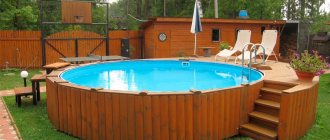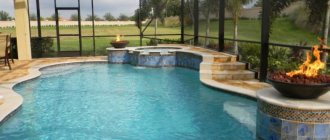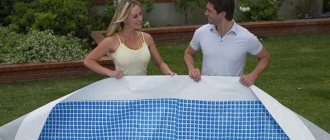After the summer, owners of frame pools are faced with the problem of how to completely disassemble the structure or carry out conservation. It all depends on the specific model. If you are going to store your pool in winter, you must carefully study all the rules and recommendations. Improper storage will lead to disastrous consequences, including the appearance of defects and damage to the elastic coating. To avoid additional losses, we recommend that you learn in detail how to store a frame pool in winter.
The story of one happy pool
This true story directly relates to the topic of the article. It happened and continues to happen successfully with our good friends.
Proper preservation and care of the pool bowl even in Siberia!
...The long-awaited and only daughter was born into an elderly family. The happy parents immediately equipped the yard with all kinds of children's swings, houses, and sandboxes. We didn’t lose sight of the pool by purchasing a frame Intex. By the time the pool was installed, the girl was 8 months old. As soon as it got warmer, little Irinka started swimming in clean homemade water! Wonderful, isn't it?
...Now the girl is 9 years old and the pool is still in service and is not going to give up. During this time, its owners only glued the bottom twice. The key to success is the proper operation and maintenance of the pool. Storing the pool bowl in winter and proper care in autumn is one of the main activities.
We deal with EVERY nuance of storing a frame pool in winter.
Storage rules
Proper storage of the pool in winter directly determines the condition in which it will meet the new season.
How to wash and clean before wintering?
The classic way to clean a seasonal pool from dirt and plaque:
- Cleaning begins by opening the drain hole. If detergents were added to the water before, it must be drained strictly into the sewer system, preventing it from getting into the soil.
- The remaining water is scooped out with a regular ladle.
- Using a brush with synthetic bristles, carefully clean the plastic sheet of the pool from silt. It is not recommended to use a wire brush - it can easily damage the material.
Experienced seasonal pool users have come up with many interesting cleaning methods.
Here are some of these recommendations:
- Having drained the water to a level just below the knees, you need to clean the walls with a brush, wetting it in water. The pump continues to operate and pump out water. Then, using a standard vacuum cleaner attached to the pump, vacuum the bottom of the pool. Finally, wipe the bottom with a cloth and leave to dry for a day.
- You can also drain the water by gravity by attaching a hose to the drain hole. Of course, this process will take several hours.
- When installing a pool under the bowl, it is recommended to make a recess: then, after draining, the remaining water will collect there, and it will be easy to scoop it out without driving water all over the bottom of the pool.
How to unmount?
The method of folding the plastic bowl depends on the shape of the tank:
- If the pallet is rectangular, it should be folded like a sheet, avoiding folds and creases.
- Folding a round bowl begins by laying the walls inward, after which the bottom is folded in half twice. The result is a triangle, which is further reduced to a convenient size.
- If there is a cable inside, then it is removed from the loops.
Before folding the fabric, check drying of all folds and hard-to-reach places so that not a single drop of water remains. Only a perfectly dried pool is guaranteed to last until the next season. Small bowls can be dried by hanging them on lines.
The frame is quite easy to disassemble:
The pins are unscrewed, the side and bottom hinges are disconnected, and the beams are removed. The vertical supports are dismantled, the nozzles, hinges and hinges of the awning are removed. During the dismantling process, it is important not to forget to rinse the drain hoses: it is good to do this with a mixture of citric acid and Feri-type dishwashing detergent. All components are marked and placed in packaging.
How and where to save structural parts?
The frame parts (unlike the bowl) can withstand storage at low temperatures. Therefore, once packaged and labeled, they can easily be left in a garage or country house for the winter. As for the bowl, it needs to be stored only in a heated room.
The pool liner is perfectly stored in the vegetable store. Holes that form in places where there are creases can be repaired with self-adhesive cheap patches: such repairs can withstand one season just fine.
Is it possible to leave a swimming pool in the winter?
Dismantling the bowl of a frame pool for the winter is a troublesome and time-consuming task. The following point is also confusing: after being in use, the product loses its original strength. Owners of a summer accessory are tempted to leave everything as is. Some pools can actually be disassembled to a minimum.
Advice from Chistyuli. A frame pool does not need to be disassembled for the winter if the structure is made of all-season materials, that is, frost-resistant. The inflatable pool is washed, drained, and dried at home. You cannot leave the inflatable bowl outside.
If you live in a warm climate, where winter frosts are very rare, you can safely leave the pool without disassembling it. However, in the northern regions, even swimming pools installed in unheated buildings need conservation. Severe frosts reach the remaining water in the equipment and the containers burst.
What are the features of storing a frame pool “recessed” into the ground in winter? There is ambiguous opinion regarding pools buried in the ground. Owners of such structures claim that pools survive the winter without problems, while the water remains in the bowl. Experts explain that when the soil freezes, it puts pressure on the walls of the pool. In turn, the water remaining in the bowl also freezes and puts pressure on the walls. Over time, serious deformation of the structure occurs.
How to re-open before the start of the swimming season?
With the onset of warm spring days, I want to put my home pond into operation as quickly as possible. This must be done correctly.
Seasonal model
Before installing a seasonal pool, first tidy up the area where it will be located:
- The area is cleared of garbage.
- The area is leveled and a bedding is laid on it to protect the bottom of the pool.
- The stakes are driven in onto which the frame is stretched.
- All parts should first be washed and the pool rinsed.
Frost-resistant pond
Under no circumstances should you break blocks of ice with a crowbar ! You must wait until the ice melts naturally.
You need to start cleaning a stationary pool after winter as soon as the night air temperature reaches 10 degrees. If you wait until it gets hot, the water will certainly “bloom.”
If the pool was covered from above for the winter, then there will be much less debris in it than in an open one.
But in any case, careful cleaning and washing with disinfectants will be required:
Having descended into the bowl, you should thoroughly rinse every corner of the pool. This is done using brushes and/or vacuum cleaners. Special chemicals for swimming pools should be added to the water, which does not create foam (it will be very difficult to get rid of foam after draining the water).- Remove the winter plugs from the injectors and skimmer.
- After de-energizing the system, install spotlights.
- Install stairs and handrails.
- Connect pumps and filters.
- Install disinfection equipment.
- Fill the pool with water, exceeding the level of the middle of the skimmer by 3-5 cm.
- Adjust the acidity of the water.
- Shock the water with a chlorine-containing substance.
- Without turning off the filtration, leave the pool for 1 day.
- Dirt that has collected at the bottom in the form of sediment must be carefully collected with a vacuum cleaner.
- The filter needs to be washed a couple of times.
- Turn on the ultraviolet and filtration system.
After all these procedures are completed, the pool will be fully prepared for use.
Why does the pool need to be dismantled?
Despite the manufacturer’s promise that the bowl will feel good even in cold weather, it is worth the effort and dismantling of any product, including all-season products. Some environmental factors can cause spoilage. These include:
- Extreme drop in temperature.
- Large temperature changes.
- Heavy snowfalls, hail.
- Hurricane winds and thunderstorms can demolish the pool or deform the walls and bottom.
- Precipitation will constantly moisten the pool, certainly falling into the bowl.
Agree, the vagaries of nature are beyond human control. It remains to figure out how to store a frame pool during the cold season. I continue the list of possible problems.
- Over a long winter, the soil may swell. To counteract heaving, it is recommended to leave plenty of water, which will stop the process under the influence of its own weight.
- There is a good chance that the lower nozzles will freeze into the ice and will simply be torn out of the bowl when the ice thaws in the spring and water accumulates at the bottom of the pool. In addition, water also remains inside the nozzles, which can easily tear the structure.
- Temperature fluctuations will cause the water to either freeze or thaw, which is also harmful for the pool and its plastic.
- Attempts by representatives of the local fauna are especially important for a swimming pool left unattended at a dacha.
- Hooligan antics of uninvited visitors to the summer cottage.
- Theft of property left unattended for a long time.
What are the disadvantages of a frost-resistant pool?
Despite a number of advantages, all-season frame pools have some disadvantages:
- Installation of the pool
In order for the pool to serve for a long time and reliably perform its functions, you should entrust its installation to specialists. There is no need to look for trusted professionals; when ordering pools on our website, we will provide qualified installers with the necessary knowledge and experience. - Landscaping
Before installing a pool, it is necessary to remove the top layer of soil and level the surface. If there is a desire and opportunity, the pool can be “sinked” relative to the ground level by arranging the area around it using tiles or stones. It takes some extra effort, but it looks great. Fortunately, landscaping the area around the pool is not necessary. - The cost of frost-resistant pools
The cost of “all-season” pools is higher than mobile summer pools, but it is not comparable to the costs of installing a regular stationary pool. Considering the time and financial resources that will be spent on design, materials and construction, using a steel frame is much more profitable. If you like winter swimming in a warm pool, choose an all-season mobile option. If necessary, it can always be dismantled and moved to a new location.
Go to the catalog of frost-resistant frame pools
How to dismantle a pool
Here's how to properly store a frame pool in winter so as not to damage the soft font. When preparing a pool for conservation, the following recommendations from manufacturers will be useful:
- Start preparing immediately at the end of the swimming season. Don't expect heavy rains or frost. It will take several days to prepare for storage.
- The right chemical will help clean the bowl and parts of the pool without causing damage. When choosing chemistry, keep in mind that you will have to deal with plastic and metal.
- Take care of auxiliary accessories: rags, soft brushes, sponges.
- Make sure in advance that you have enough space to drain a large volume of water.
Let me remind you that only water free of reagents can be poured into the soil. If you add detergent, disinfectant, or bleach to the pool, the chemicals will simply scorch the ground. Next year there will be a bald patch without plants.
Video. Winter maintenance of the pool
Preservation of frost-resistant structures
Some swimming pools of popular brands cannot be disassembled - this option is not possible due to design features. The most popular frost-resistant models are produced by the GRE and Bestway brands.
All-season products have several layers: vinyl (protecting the water from rapid cooling) and metal (preventing damage to the bowl). How to store a non-demountable frame pool in order to get a complete product ready for use in the spring?
- Carry out all work in dry, warm weather.
- Remove the disinfectant dispenser from the built-in autochlorinator.
- Turn on the system's automatic flushing for 20-30 minutes. This feature is not available for every pool. Add a preservative to the code so that the pump circulates it throughout the system. Remember that you cannot pour water with preservatives into the soil or reservoirs. Use the sewer, save nature.
- Drain the water thoroughly. Pay attention to all elements that will not be dismantled - they also need to be COMPLETELY freed from water.
- Drain the water, simultaneously cleaning all the elements from plaque. Use chemicals approved by the manufacturer. Use a soft brush or rag. Pay attention to ground structures and dismantled elements: stairs, railings, backlights, etc. You should not leave water used for bathing for conservation.
Advice from Chistyuli . There are horror stories on forums about how a swimming pool has to be filled with purchased water, since the local water looks like a cultivated swamp. The owners of such pools are unlikely to drain the “golden” water. In this case, preserve the structure as if it were frost-resistant.
Let's continue...
- Remove all possible components: protective glass, lights, etc.
- Take care of the wiring insulation. In the places where dismantled electrical products are installed, place dense dielectric plugs (they can be easily made from foam plastic).
- Dry the non-removable parts and wrap hermetically in cling film. Also make sure that all openings are closed.
- Fill the pool, cleaned of dirt and chemicals, 2/3 full with clean water with the addition of special products for winter storage: “Puripul Bayrol”, “Winterpool”, etc., diluted in a ratio of 1:5. This will protect the water from the development of bacteria. Or perform shock chlorination. You cannot leave a pool without water over the winter.
Shock chlorination of a pool is performed using special means. AquaDoctor C-60 and C-60T are popular. Dosage 20 grams / 1 cubic meter of water. Shock chlorination is repeated in the spring before the start of operation and repeated every 45-60 days in the summer.
- Install compensators: several five-liter bottles at the rate of 1 bottle per square meter of area. Using counterweights, drown the bottles to ¾ of their volume. As a counterweight, use sand or small pebbles, filled halfway into each bottle. When water freezes, the bottles will become deformed, but the bowl will remain unchanged. Compensators protect the thicket from fractures and deformation. When installing, distribute them evenly over the entire area of the pool. It is convenient to place bottles diagonally in one row or crosswise. The distance between compensators is 10-15 cm.
- How to store a frame pool in winter? Adjust the water level so that it is 15-20 cm below the return nozzles. After lowering the compensators into the water, the water level will rise. Adjust it again.
- I recommend using a special covering awning - a winter “blanket”, which can be purchased complete with the pool. Pour more water onto the awning - it will press the blanket to the edges of the pool, which will create additional sealing and at least partially protect from the wind.
Winter preservation rules
If you have an all-season model in mind, then in order to avoid damage to the equipment and perform quality conservation, you must adhere to the following recommendations:
the tank must be preserved until the air temperature drops to 0°;- The pool bowl must be filled with water;
- Water should be added only after cleaning work has been carried out inside the pool and the equipment has been removed;
- When cleaning tank walls with special compounds, precautions should be taken because they are toxic;
- Removal of equipment inside the tank must be done carefully so that the hydraulic system is not damaged.
It is prohibited to add preservatives to water intended for swimming!
Seasonal models begin to be dismantled, after draining the water. The procedure is not particularly difficult, but compliance with some rules is mandatory:
- Simultaneously with draining the water, it is necessary to thoroughly clean the entire internal surface. First of all, completely remove limescale from the metal parts of the structure.
- To prevent small structural parts from getting lost, it is better to pack each of them separately.
- You need to dry the pool as best as possible.
- If heating is not provided in the room where the dismantled structure will be stored, dense packing of the material is required, because Due to its fragility, it can be damaged by exposure to low temperatures.
Where to store the pool
How to properly store a non-frost-resistant frame pool in winter? Plastic parts of such structures are afraid of frost, so a room with above-zero temperatures is suitable, but not hot. A rolled up pool takes up a lot of space, so in a pinch, utility rooms are suitable:
- attic
- canopy
- barn
- garage
- basement
- summer cuisine
- greenhouse
- workshop
- cellar
- pantry, balcony, loggia
The optimal temperature for storing a frame pool is from 0 to 40℃, ideal 18℃. To avoid mold, the room must be dry and with a minimum humidity threshold. Deny access to any animals, both domestic and wild.
Warehousing
Once all the air has come out of the walls, you can begin to carefully fold the pool, trying to smooth out the wrinkles. The fact is that when storing a pool in winter, the materials become rougher and creases appear, which in the future can lead to a decrease in the quality of the fabric and the appearance of punctures. The rolled structure is usually placed in a bag or box; it is important that the container is dry. It would be a good idea to sprinkle the top of the walls with talcum powder; this is done to prevent the walls from sticking together. It is not necessary to do this in the summer. The storage room must be dark, not humid and at the temperature specified in the instruction manual or on the packaging.











